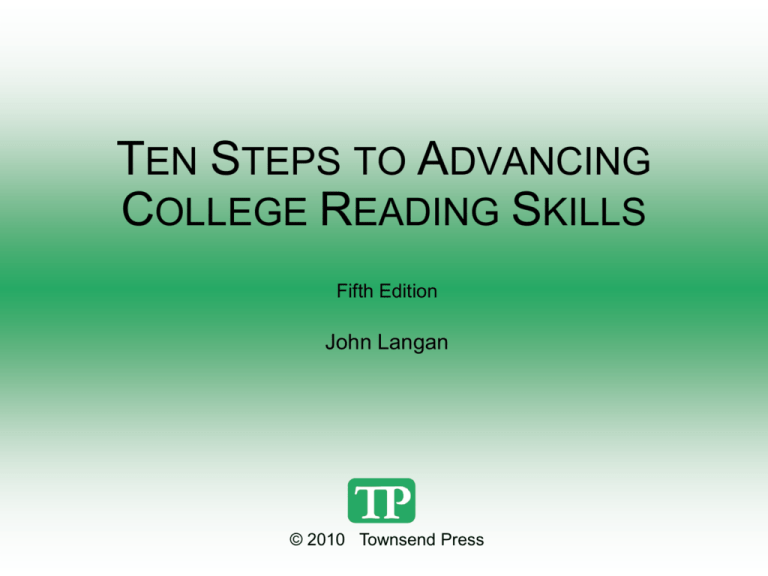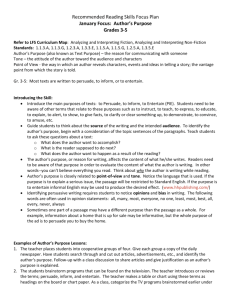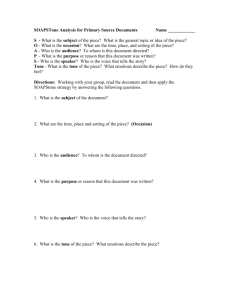
TEN STEPS TO ADVANCING
COLLEGE READING SKILLS
Fifth Edition
John Langan
© 2010 Townsend Press
Chapter Eight:
Purpose and Tone
There is an author—a person with thoughts, feelings,
and opinions—behind everything you read.
Authors write from a personal point of view.
That point of view is reflected in
• the purpose of a piece of writing—to inform, to
persuade, or to entertain—and
• its tone — the expression of attitude and feeling.
PURPOSE AND TONE
The purpose of this cartoon, like all cartoons, is to
entertain.
Can you tell what the tone of each speaker is? Which
one actually means what he or she is saying? Which
one does not?
REAL LIFE ADVENTURES © 2008 GarLanco, Reprinted with permission of UNIVERSAL PRESS SYNDICATE. All rights reserved.
PURPOSE AND TONE
The man means what he is saying. He is asking the woman to
go on an errand with him, so we can assume he enjoys and
desires her company.
The woman does not mean what she is saying. Few people
would consider a trip to drugstore a “fun date,” so we can infer
she is being sarcastic, saying the opposite of what she means.
REAL LIFE ADVENTURES © 2008 GarLanco, Reprinted with permission of UNIVERSAL PRESS SYNDICATE. All rights reserved.
PURPOSE
Three common purposes (reasons for writing) are:
• To inform — to give information about a subject.
• To persuade — to convince the reader to agree
with the author’s point of view on a subject.
• To entertain — to amuse and delight; to appeal
to the reader’s senses and imagination.
PURPOSE
The cover and title of anything you read often suggest the
author’s primary purpose. What do you think is the main
purpose of each of these books?
Primary purpose:
A. to inform
B. to persuade
C. to entertain
Primary purpose:
A. to inform
B. to persuade
C. to entertain
Primary purpose:
A. to inform
B. to persuade
C. to entertain
PURPOSE
The cover and title of anything you read often suggest the
author’s primary purpose. What do you think is the main
purpose of each of these books?
Primary purpose:
A. to inform
B. to persuade
C. to entertain
Primary purpose:
A. to inform
B. to persuade
C. to entertain
Primary purpose:
A. to inform
B. to persuade
C. to entertain
PURPOSE
Read the paragraph below and decide what the author’s purpose is.
Athletes should not earn millions of dollars a year. If they weren’t
paid so much, then tickets to sports events wouldn’t have to be so
expensive, and more people could enjoy sports more often. Also, more
reasonable pay would make for better role models for young people,
many of whom look up to sports figures.
Primary purpose:
A. to inform
B. to persuade
C. to entertain
PURPOSE
Athletes should not earn millions of dollars a year. If they weren’t
paid so much, then tickets to sports events wouldn’t have to be so
expensive, and more people could enjoy sports more often. Also, more
reasonable pay would make for better role models for young people,
many of whom look up to sports figures.
Primary purpose:
A. to inform
B. to persuade
C. to entertain
The author wants to persuade us that “athletes should not earn millions
of dollars every year.” The word should is a clue. Words like should, ought,
and must are often used to persuade.
PURPOSE
Read the paragraph below and decide what the author’s purpose is.
The Bubonic plague, also called the Black Death, swept Europe,
Asia, and Africa from 1346 to 1353. So deadly was this disease that it
killed one-third of the population of these continents. The plague was
spread by fleas infected with bacteria from diseased rats. When it resulted
in pneumonia, coughing spread the bacteria directly through the air.
Primary purpose:
A. to inform
B. to persuade
C. to entertain
PURPOSE
The Bubonic plague, also called the Black Death, swept Europe,
Asia, and Africa from 1346 to 1353. So deadly was this disease that it
killed one-third of the population of these continents. The plague was
spread by fleas infected with bacteria from diseased rats. When it resulted
in pneumonia, coughing spread the bacteria directly through the air.
Primary purpose:
A. to inform
B. to persuade
C. to entertain
The author is providing us with factual details about the Black
Death.
PURPOSE
Read the paragraph below and decide what the author’s purpose is.
Men don’t even notice 97 percent of the beauty efforts women
make. For example, the average woman spends five thousand hours per
year worrying about her fingernails. But I have never once, in more than
forty years of listening to men talk about women, heard a man say, “She
has a nice set of fingernails!” Many men would not notice if a woman
had upward of four hands.
Primary purpose:
A. to inform
B. to persuade
C. to entertain
PURPOSE
Men don’t even notice 97 percent of the beauty efforts women
make. For example, the average woman spends five thousand hours per
year worrying about her fingernails. But I have never once, in more than
forty years of listening to men talk about women, heard a man say, “She
has a nice set of fingernails!” Many men would not notice if a woman
had upward of four hands.
Primary purpose:
A. to inform
B. to persuade
C. to entertain
In order to entertain us, the author uses playful and exaggerated
details about women’s efforts to look beautiful.
WRITING WITH MORE THAN ONE PURPOSE
At times writing may blend two or even three purposes.
The main purpose of your textbook for this course is to inform.
WRITING WITH MORE THAN ONE PURPOSE
At times writing may blend two or even three purposes.
The main purpose of your textbook for this course is to inform.
But the purpose of “Some Quick Study Tips” on pages 9 and 10 is
to inform and to persuade.
WRITING WITH MORE THAN ONE PURPOSE
At times writing may blend two or even three purposes.
“The explanation is that
you’ve been eating too much
pepperoni pizza, Mr. Jones.”
The main purpose of your textbook for this course is to inform.
But the purpose of “Some Quick Study Tips” on pages 9 and 10 is
to inform and to persuade. And the purpose of the cartoons in the
book is to inform and to entertain.
TONE
• A writer’s tone reveals the attitude he or she
has toward a subject.
• Tone is expressed through the words and
details the writer selects.
TONE
Below are three statements by employees of a fast-food
restaurant. Notice the differences in tone.
“I have no doubt that flipping burgers and toasting buns will prepare
me for a top position on Wall Street.”
Tone: mocking, sarcastic
“I love working at Burger Barn. I meet interesting people, earn extra
money, and get to eat all the chicken nuggets I want when I go on
break.”
Tone: enthusiastic, positive
“I’m not excited about wearing fluorescent green polyester uniforms,
but the managers are willing to schedule me around my classes, and
the company offers scholarships to hard-working employees.”
Tone: fair-minded, objective
TONE
Here is another statement by an employee of a fast-food
restaurant. How would you describe the tone?
“I hate this job. The customers are rude, the managers
are idiots, and the food smells like dog chow.”
TONE
Here is another statement by an employee of a fast-food
restaurant. How would you describe the tone?
“I hate this job. The customers are rude, the managers
are idiots, and the food smells like dog chow.”
Tone: bitter, angry
TONE
Pages 336 and 337 in your textbook list more
than fifty words that describe tone.
TONE
What is the tone of each of the following statements?
Unfortunately, this car is a lot less reliable than I’d like.
The tone is:
A. optimistic B. disappointed
C. caring
It’s not the greatest car in the world, but it usually takes
me where I have to go.
The tone is:
A. angry
B. humorous
C. tolerant
TONE
What is the tone of each of the following statements?
Unfortunately, this car is a lot less reliable than I’d like.
The tone is:
A. optimistic B. disappointed
C. caring
The words unfortunately and less reliable than I’d like indicate the
disappointed tone.
It’s not the greatest car in the world, but it usually takes
me where I have to go.
The tone is:
A. angry
B. humorous
C. tolerant
The phrase usually takes me where I have to go shows the writer’s
accepting attitude and signals a tolerant tone.
TONE
A Note on Irony
• One commonly used tone is irony.
• When writing has an ironic tone, it says one
thing but means the opposite.
TONE
A Note on Irony
Below are three examples of verbal irony (also known as
sarcasm).
Notice the quotation in each says the opposite of what is
meant.
— If the price tag on a shirt you like is double what you’d
expect, you might mutter, “What a bargain.”
— After sitting through the first session of what is clearly going
to be a very boring class, you say to a classmate, “I only
hope you can stand all the excitement.”
— After seeing your favorite basketball team play its worst
game ever, you might comment, “I knew they wouldn’t
disappoint me.”
TONE
A Note on Irony
Irony also refers to situations in which what happens is the
opposite of what we might expect.
In the cartoon below, it is ironic that the father who expects
his son to clean his room permits himself to have a very
messy environment.
Adam@Home © Universal Press Syndicate. Reprinted by permission of Universal Press Syndicate. All rights reserved.
TONE
A Note on Irony
Here are two more examples of situations in which what
happens is the opposite of what we might expect.
— A doctor tells a man that he’d better exercise if he wants to
stay healthy. So the man begins jogging. One day while jogging
across the street, he is hit by a truck and dies instantly.
— A woman loved dancing, but her boyfriend did not dance
well. So she insisted he take dancing lessons. After he
started taking lessons, he fell in love with his dancing teacher.
TONE
A Note on Irony
Look at the cartoon below. Then decide whether the quotation is straightforward
or ironic (in which what is said is sarcastically the opposite of what is really meant).
1. “If we know our senior executive is making a bad decision,
shouldn’t we tell her?”
A. straightforward
B. ironic
DILBERT © Scott Adams. Distributed by United Feature Syndicate, Inc.
TONE
A Note on Irony
Look at the cartoon below. Then decide whether the quotation is straightforward
or ironic (in which what is said is sarcastically the opposite of what is really meant).
1. “If we know our senior executive is making a bad decision,
shouldn’t we tell her?”
A. straightforward
B. ironic
The speaker is asking a straightforward question. He is serious.
DILBERT © Scott Adams. Distributed by United Feature Syndicate, Inc.
TONE
A Note on Irony
Look at the cartoon below. Then decide whether the quotation is straightforward
or ironic (in which what is said is sarcastically the opposite of what is really meant).
2. “Let’s end our careers by challenging a decision that won’t
change. That’s a great idea.”
A. straightforward
B. ironic
DILBERT © Scott Adams. Distributed by United Feature Syndicate, Inc.
TONE
A Note on Irony
Look at the cartoon below. Then decide whether the quotation is straightforward
or ironic (in which what is said is sarcastically the opposite of what is really meant).
2. “Let’s end our careers by challenging a decision that won’t
change. That’s a great idea.”
A. straightforward
B. ironic
The speaker is saying the opposite of what he means. For example, when
he says, “That’s a great idea,” he really means, “That’s a terrible idea.”
DILBERT © Scott Adams. Distributed by United Feature Syndicate, Inc.
TONE
A Note on Irony
Look at the cartoon below. Then decide whether the quotation is straightforward
or ironic (in which what is said is sarcastically the opposite of what is really meant).
3. “And let’s pull our neckties until it hurts.”
A. straightforward
B. ironic
DILBERT © Scott Adams. Distributed by United Feature Syndicate, Inc.
TONE
A Note on Irony
Look at the cartoon below. Then decide whether the quotation is straightforward
or ironic (in which what is said is sarcastically the opposite of what is really meant).
3. “And let’s pull our neckties until it hurts.”
A. straightforward
B. ironic
This statement continues the irony by suggesting that causing themselves
pain is as good an idea as challenging the boss’s decision.
DILBERT © Scott Adams. Distributed by United Feature Syndicate, Inc.
CHAPTER REVIEW
In this chapter, you learned that part of effective reading is to do the following:
• Be aware or an author’s purpose: the reason he or she writes. Three
common purposes are to inform, to persuade, and to entertain.
• Be aware of tone: the expression of the author’s attitude and feeling
about the subject. A writer’s tone might be objective—the case in
most textbook writing—or it might be lighthearted, sympathetic,
angry, affectionate, respectful, or any of many other tones.
• One important tone to recognize is irony: saying one thing but
meaning the opposite.
The next chapter—Chapter 9—will explain another part of effective reading:
recognizing an author’s point in an argument and evaluating the support for
that point.






